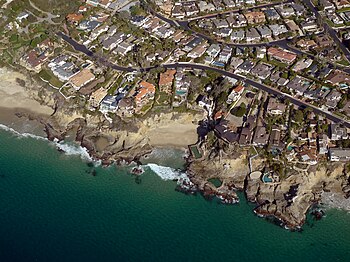Contents

Coastal California, also known as the California Coastline and the Golden Coast, refers to the coastal regions of the U.S. state of California. The term is not primarily geographical as it also describes an area distinguished by cultural, economic and political attributes.
Geography

The area includes the North Coast, San Francisco Bay Area, Central Coast, and South Coast. The coastline is slowly eroding due to natural processes and potentially accelerated by climate change, though much more slowly in other places in the United States. In the last 100 years, the water line has risen less than 6 in (150 mm) along the coast of California. In the next 100 years, the water is expected to surge as much as 9 ft (2.7 m), bringing into question the fate of the many million dollar homes settled right on the edge of the sea.[1][2]
Climate
Coastal California is heavily influenced by east–west distances to the cold California Current (dominated by it) and microclimates due to hills and coast ranges, having strong ecological effects, summer and winter temperatures other than occasional heat waves are heavily moderated by ocean currents and fog with strong Seasonal lags compared to interior valleys as little as 10 mi (16 km) away. Point Conception tends to divide the Coastal region by mid-summer into warmer (south and east) and cooler zones (north). Peak and often intense heat tends to arrive in September much later than the rest of the nation or state. Over time, droughts and wildfires have increased in frequency and become less seasonal and more year-round, further straining the region's water security.[3][4][5]
Counties



The counties commonly seen as constituting coastal California are:
Demographics
During the 2000 Census, roughly a third of households had incomes exceeding $75,000, compared to 17.6% in the Central Valley[6] and 22.5% at the national average.[7] While the area has always been relatively expensive, when compared to inland regions and the national average, the recent[when?] real estate boom has left it as the most expensive housing market in the nation. An October 2004 CNN Money publication found that a 2,200-square-foot (200 m2) home in a "middle management neighborhood" would cost an average of $1.8 million.[8]
See also
- California Coast Ranges
- California Coastal Records Project low altitude photographs of the entire coast
- California State Route 1
- California's congressional districts
- Greater Los Angeles Area
- Left Coast
References
- ^ Xia, Rosanna (July 7, 2019). "The California coast is disappearing under the rising sea. Our choices are grim". Retrieved July 8, 2019.
- ^ Milman, Oliver (October 11, 2018). "Sinking Santa Cruz: climate change threatens famed California beach town". The Guardian. Retrieved 2020-02-04.
- ^ www.drought.gov https://www.drought.gov. Retrieved November 20, 2021.
{{cite web}}: Missing or empty|title=(help)[title missing] - ^ Boxall, Bettina; St. John, Paige (November 10, 2018). "California's most destructive wildfire should not have come as a surprise". Los Angeles Times. Retrieved November 11, 2018.
- ^ "Advancing Drought Science and Preparedness across the Nation". National Integrated Drought Information System. Archived from the original on November 11, 2018. Retrieved November 11, 2018.
- ^ "Stanford University, income in California" (PDF). Archived from the original (PDF) on 2007-06-14. Retrieved 2007-05-28.
- ^ "US Census Bureau, US household income". Archived from the original on 2007-06-21. Retrieved 2007-05-28.
- ^ "CNN Money, housing markets". Retrieved 2007-05-28.
External links
![]() Media related to California Coast at Wikimedia Commons
Media related to California Coast at Wikimedia Commons
- Geology of the California Coast Archived 2016-03-04 at the Wayback Machine by geologist Andrew Alden Archived 2016-11-10 at the Wayback Machine

